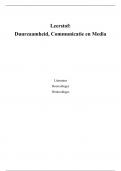Leerstof:
Duurzaamheid, Communicatie en Media
Literatuur
Hoorcolleges
Werkcolleges
,INHOUD
Week 1: Duurzaamheid en communicatie
• Marshall, J. D., & Toffel, M. W. (2005). Framing the elusive concept of sustainability: A
sustainability hierarchy. Environmental science & technology, 39(3), 673-682.
• Fischer, D., Lüdecke, G., Godemann, J., Michelsen, G., Newig, J., Rieckmann, M., & Schulz,
D. (2016). Sustainability communication. Sustainability science: an introduction, 139-148.
• Hoorcollege 1
Week 2: Duurzaamheidsframes in de media
• O'Neill, S., Hayes, S., Strauβ, N., Doutreix, M. N., Steentjes, K., Ettinger, J., ... & Painter, J.
(2023). Visual portrayals of fun in the sun in European news outlets misrepresent heatwave
risks. The Geographical Journal, 189(1), 90-103. https://doi.org/10.1111/geoj.12487
• Spence, A., & Pidgeon, N. (2010). Framing and communicating climate change: The effects of
distance and outcome frame manipulations. Global Environmental Change, 20(4), 656-
667. http://dx.doi.org/10.1016/j.gloenvcha.2010.07.002
• Hoorcollege 2
Week 3: Duurzaamheid in entertainment
• Pabian, S., Hudders, L., Poels, K., Stoffelen, F., & De Backer, C. J. (2020). Ninety minutes to
reduce One's intention to eat meat: A preliminary experimental investigation on the effect of
watching the Cowspiracy documentary on intention to reduce meat consumption. Frontiers in
Communication, 5, 69. https://doi.org/10.3389/fcomm.2020.00069
• McCormack, C. M., K Martin, J., & Williams, K. J. (2021). The full story: Understanding how
films affect environmental change through the lens of narrative persuasion. People and
Nature, 3(6), 1193-1204. https://doi.org/10.1002/pan3.10259
• Hoorcollege 3
Week 4: Duurzaamheid en gedragsverandering
• Eyster, H. N., Satterfield, T., & Chan, K. M. (2022). Why people do what they do: an
interdisciplinary synthesis of human action theories. Annual Review of Environment and
Resources, 47(1), 725-751.
• White, K., Habib, R., & Hardisty, D. J. (2019). How to SHIFT consumer behaviors to be more
sustainable: A literature review and guiding framework. Journal of Marketing, 83(3), 22-49.
• Meijers, M. H., Remmelswaal, P., & Wonneberger, A. (2019). Using visual impact metaphors
to stimulate environmentally friendly behavior: The roles of response efficacy and evaluative
persuasion knowledge. Environmental Communication, 13(8), 995-1008
• Hoorcollege 4
Week 5: Symposium
• Presentatie van Dr. Laura Loy (Rheinland-Pfälzische Technische Universität Kaiserslautern –
Landau) Global identity – A path towards climate protection?
• Presentatie van Dr. Sandra Klaperski-van der Wal (Behaviour Change and Wellbeing group,
BSI, Radboud University) Let’s talk about heat baby, let’s talk about you and me: Climate
change conversations, norm perceptions, and sustainable behavior.
, • Presentatie van Dr. Jeroen Jonkman (University of Amsterdam) Navigating between
stakeholders and publics: Strategic communication in the low-carbon energy transition.
Week 6: Duurzaamheid en wetenschapscommunicatie
• Meijers, M. H., & Rutjens, B. T. (2014). Affirming belief in scientific progress reduces
environmentally friendly behaviour. European Journal of Social Psychology, 44(5), 487-
495. https://doi.org/10.1002/ejsp.2009
• Nisbet, M. C., & Scheufele, D. A. (2009). What's next for science communication? Promising
directions and lingering distractions. American Journal of Botany, 96(10), 1767-
1778. https://doi.org/10.3732/ajb.0900041
• Van der Linden, S. L., Leiserowitz, A. A., Feinberg, G. D., & Maibach, E. W. (2015). The
scientific consensus on climate change as a gateway belief: Experimental evidence. PloS
one, 10(2), e0118489. https://doi.org/10.1371/journal.pone.0118489
• Hoorcollege 6
Week 7: Greenwashing en misinformatie
• Treen, K. M. D. I., Williams, H. T., & O'Neill, S. J. (2020). Online misinformation about
climate change. Wiley Interdisciplinary Reviews: Climate Change, 11(5), e665.
• Samoilenko, S. A., & Cook, J. (2024). Developing an Ad Hominem typology for classifying
climate misinformation. Climate Policy, 24(1), 138-151.
• Schmuck, D., Matthes, J., & Naderer, B. (2018). Misleading consumers with green
advertising? An affect–reason–involvement account of greenwashing effects in environmental
advertising. Journal of Advertising, 47(2), 127-145
• Hoorcollege 7
, Week 1: Duurzaamheid en communicatie
Artikel Marshall, J. D., & Toffel, M. W. (2005). Framing the elusive concept of sustainability: A
sustainability hierarchy. Environmental science & technology, 39(3), 673-682.
Onderzoek naar de betekenis van Duurzaamheid
Het artikel van Marshall & Toffel is geen traditioneel onderzoek met een specifiek experiment of data-
analyse. In plaats daarvan analyseert het de bestaande literatuur en het discours rondom duurzaamheid
om een beter begrip te krijgen van dit veelgebruikte, maar vaak onduidelijke concept.
De auteurs constateren dat er een "definitie-chaos" bestaat rondom duurzaamheid. Er zijn talloze
definities en interpretaties in omloop, waardoor het begrip aan betekenis en bruikbaarheid verliest. Om
meer duidelijkheid te scheppen, introduceren ze een "Duurzaamheidshiërarchie" met vier niveaus.
Deze hiërarchie categoriseert verschillende manieren waarop duurzaamheid wordt gebruikt, van het
waarborgen van menselijke overleving tot het bevorderen van levenskwaliteit.
Belangrijkste begrippen, theorieën en modellen:
• Duurzaamheid: De auteurs benadrukken dat er geen universeel geaccepteerde definitie is. Ze
citeren de definitie van de Brundtland Commissie: "duurzame ontwikkeling is ontwikkeling
die voorziet in de behoeften van de huidige generatie zonder het vermogen van toekomstige
generaties om in hun eigen behoeften te voorzien in gevaar te brengen". Ze bekritiseren deze
definitie echter ook omdat deze moeilijk te operationaliseren is.
• Duurzaamheidsframeworks: Het artikel bespreekt vier belangrijke frameworks:
o The Triple Bottom Line: Dit model pleit voor een geïntegreerde aanpak die rekening
houdt met economische, ecologische en sociale aspecten. De auteurs wijzen echter op
de kritiek dat dit model vaag is en moeilijk te meten.
o The Natural Step: Dit framework definieert een duurzame samenleving aan de hand
van vier systeemvoorwaarden, gericht op het minimaliseren van de menselijke impact
op het milieu.
o The Ecological Footprint: Dit framework kwantificeert de menselijke impact op het
milieu door de benodigde natuurlijke hulpbronnen af te zetten tegen de capaciteit van
de aarde om deze te regenereren.
o Sustainable Emissions and Resource Usage: Graedel & Klee stellen een methode voor
om te bepalen wat duurzame niveaus zijn voor emissies en het gebruik van
hulpbronnen, rekening houdend met regeneratie en recycling.
• Duurzaamheidshiërarchie: Dit model categoriseert verschillende interpretaties van
duurzaamheid in vier niveaus:
o Niveau 1: Acties die de overleving van de mens in gevaar brengen.
o Niveau 2: Acties die de levensverwachting of gezondheid verminderen.
o Niveau 3: Acties die leiden tot uitsterven van soorten of schending van
mensenrechten.
o Niveau 4: Acties die de levenskwaliteit verminderen of inconsistent zijn met waarden,
overtuigingen of esthetische voorkeuren.




